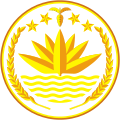| |||||||||||||||||||||||||||||||||||||
300 of the 315 seats in the Jatiya Sangsad 151 seats needed for a majority | |||||||||||||||||||||||||||||||||||||
|---|---|---|---|---|---|---|---|---|---|---|---|---|---|---|---|---|---|---|---|---|---|---|---|---|---|---|---|---|---|---|---|---|---|---|---|---|---|
| Registered | 35,205,642 | ||||||||||||||||||||||||||||||||||||
| Turnout | 54.91% | ||||||||||||||||||||||||||||||||||||
| |||||||||||||||||||||||||||||||||||||
| |||||||||||||||||||||||||||||||||||||
| This article is part of a series on the |
| Politics of Bangladesh |
|---|
 |
|
|
|
|
General elections were held in newly independent Bangladesh on 7 March 1973. A total of 1,078 candidates and 14 political parties contested the elections.
Though the Awami League was already the clear favourite before the elections, the government led by its leader Sheikh Mujibur Rahman made a major effort to winning every seat. This led to an unnecessarily rigged election in which the Awami League won 293 of the 300 directly elected seats including eleven constituencies where they were elected unopposed without a vote.[1][2] Voter turnout was 55%.[3]
The result saw a near-complete obliteration of the opposition, with most of the leadership of opposition parties failing to win seats, including Mohammad Abdul Jalil (Jatiya Samajtantrik Dal), Rashed Khan Menon, Kazi Zafar Ahmed and Aleem al-Razee (National Awami Party (Bhashani)), and Suranjit Sengupta (National Awami Party (Muzaffar)).[3][4][5]
- ^ Dieter Nohlen, Florian Grotz & Christof Hartmann (2001) Elections in Asia: A data handbook, Volume I, p535 ISBN 0-19-924958-X
- ^ Government of Bangladesh (1991). A Background Paper on Bangladesh Parliamentary Elections. Dhaka: Press Information Department (Handout No. 429).
- ^ a b Huque, Ahmed Shafiqul; Hakim, Muhammad A. (1993). "Elections in Bangladesh: Tools of Legitimacy". Asian Affairs. 19 (4): 248–261. ISSN 0092-7678.
- ^ Jahan, Rounaq (1974). "Bangladesh in 1973: Management of Factional Politics". Asian Survey. 14 (2): 125–35. doi:10.2307/2643085. JSTOR 2643085.
- ^ Franda, Marcus (1982). Bangladesh: The First Decade. Universities Field Staff International. p. 54.




